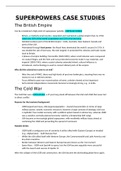SUPERPOWERS CASE STUDIES
The British Empire
Can be considered a high point of superpower polarity: UNIPOLAR WORLD
- Britain, a relatively small country, expanded and maintained a global empire that, by 1920,
ruled over 20% of the world’s population and 25% of its land area
- Notable locations part of the British Empire = India, Australia, New Zealand, Canada and
parts of the USA.
- Maintained through hard power: the Royal Navy dominated the world’s oceans (in 1914, it
was double the size of Germany, the next largest). It protected the colonies and trade routes
back to Britain.
- 2 phases of empire building: Mercantile (1600-1850), where small colonies were conquered
on coastal fringes, and the forts and navy protected economic trade in raw materials, and
imperial (1850-1945), where coastal colonies extended inland, cultural influence is
introduced, and technology is used to connect distant parts of the empire.
Why did the colonial era come to an end?
- After the end of WW2, there was high levels of post war bankruptcy, meaning there was no
money to run or defend colonies
- Focus shifted to post war reconstruction at home, colonies viewed as less important
- Anti-colonial independence movements became increasingly strong, e.g., in India.
The Cold War
The Cold War was a BIPOLAR ERA, a 45 year long stand-off between the USA and USSR that never led
to direct conflict
Reasons for the tensions/background:
- USSR largest land mass, USA largest population – shared characteristics in terms of large
military power, wealth, economic resources, however a large contrast of ideology: USA was
a capitalist, free market economy with a political system based on democracy, whereas USSR
was a socialist, centrally planned economy ruled by a dictatorship (left wing).
- USA became an increasingly global superpower, with worldwide military bases aimed at
containing the USSR and preventing the spread of communis
Notable divide:
- USSR build a contiguous core of countries it either allied with (Eastern Europe) or invaded
(e.g., Afghanistan) – built Warsaw Pact
- Whilst the USA allied itself with Western Europe, the Commonwealth and Latin America and
key Asian countries.
- Border between Western and Eastern Europe became known as the ‘Iron Curtain’
- Space Race – USSR sent Sputnik to space, but the USA became arguably more successful
with the launch and success of Apollo 11.
After the collapse of the USSR and communism, the USA became the dominating global force again.
, China
Following from the 1978 Open Door Policy, China’s economic importance in the world economy has
greatly risen. Today, it is the world’s second largest economy (only the USA’s is bigger), at $17.7
trillion.
- Due to the global shift, China hosts many of the world’s major TNCs, and has a growing
population that is technically innovative and young.
- It also has increasing geopolitical influence (permanent seat on UN Security Council)
- By 2030, it is likely that China and the USA will be more equal in terms of power
China and Africa
In recent decades, Africa has become a major trading partner for China. This involvement has
created greater interdependence: China relies on African oil and minerals, whilst Africa increasingly
imports Chinese manufactured goods and relies on Chinese investment in infrastructure.
A neo-colonial relationship: skilled and technical jobs often filled by Chinese migrant
workers, cheap Chinese imports undercut local producers, aid is tied to FDI.
A development opportunity: China has heavily invested in infrastructure, vital jobs are
created, Chinese factories and mines bring modern working practices and technology to
Africa.
BRIC Nations
What are BRIC nations?
BRIC = Brazil, Russia, India and China.
They were identified as a group of emerging powers in 2001 by Goldman Sachs banker Jim O’Neill. In
today’s world they are steadily becoming more influential due to changing industries and the
adoption of new political approaches and ideologies.
Countr Strengths Weaknesses
y
Brazil Strong agricultural economy and - Small military
exporter - Economy suffers from ‘Boom and
Growing middle class Bust’ phases
Culturally influential with 2014 - Deforestation of forests is
World Cup and 2016 Olympics uncontrolled and could affect
economy in the future
Russia Nuclear power, large military - Ageing and declining population
capacity - Extreme inequality
Huge oil and gas reserves - Difficult diplomatic and geopolitical
Permanent seat on UN security relationships with the EU and USA
council
India Youthful population - Possible future resource shortages
English is widely spoken (water and energy)
Nuclear armed - Poor transport and energy
infrastructure
- High poverty
- Poor political relations with its





